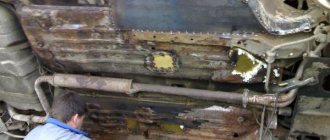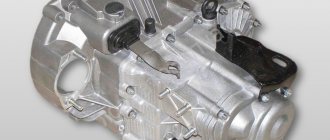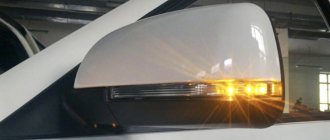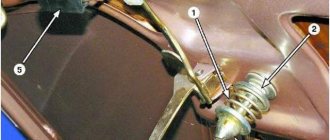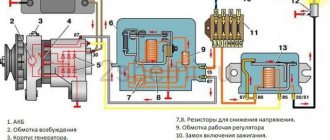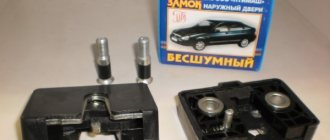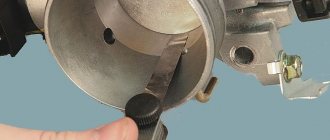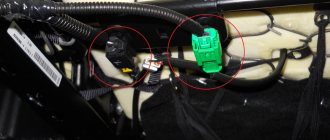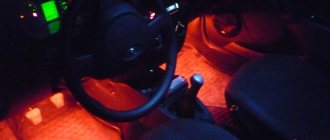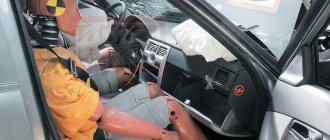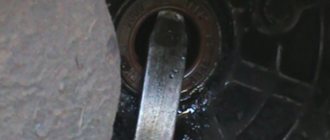Removing the central floor tunnel of the Priora
Tools required : 10mm socket, Phillips screwdriver, tall 10mm socket, flathead screwdriver.
Disconnect the negative terminal from the battery, and for ease of work you can remove the front seats. Then:
- Unscrew the nut securing the air duct to the feet of passengers in the rear seat using a 10mm socket.
- Remove the air duct. Remove the second air duct on the right side in the same way.
- Raise the armrest and pry off the armrest hinge pad.
- Remove the armrest of the Lada Priora.
- Unclip the latches to pry open the container for storing small items. Get him out of the tunnel.
- Unscrew the 2 bolts securing the armrest hinge using a 10mm socket and remove it.
- Unscrew the 4 screws securing the floor tunnel using a Phillips screwdriver.
- Through the opening, press the latch and remove the block with wires from the trunk lock control button.
- Unscrew the 2 tunnel fastening nuts using a high 10mm socket.
- Place the front seats in place and move them forward as far as possible. Unscrew the self-tapping screw securing the tunnel to the base on the left and similarly on the right, using a Phillips screwdriver.
- Remove the plastic plug at the bottom of the cup holder using a flathead screwdriver.
- Unscrew the tunnel fastening screw using a Phillips screwdriver.
- Unscrew the 2 screws securing the floor tunnel on the left and similarly on the right, using a Phillips screwdriver.
- Remove the plug in the handbrake housing using a slotted screwdriver.
- Unscrew the screw securing the side panel of the tunnel using a Phillips screwdriver.
- Remove the left tunnel shield, and similarly the right shield.
- Unscrew the screw securing the front part of the tunnel using a Phillips screwdriver. Unscrew the screw on the right side in the same way.
- Unclip the latches and remove the Priora gearbox cover. Leave the frame with the cover on the gearshift lever.
- Remove the 2 screws securing the tunnel to the instrument panel console using a Phillips screwdriver.
- Lift up the tunnel.
- Press the latch and disconnect the block with wires from the cigarette lighter. Remove the central tunnel of the Priora.
Installation of the tunnel lining is carried out in the reverse order.
VAZ Lada Priora Removal and installation of floor tunnel linings
Please enable JavaScript!
11.15.4. Removal and installation of floor tunnel linings
You will need: a 10mm wrench, flat and Phillips blade screwdrivers.
1. Disconnect the wire from the negative terminal of the battery.
| 2. Remove the screws securing the left and right screen... | 3. ...and remove the screens. |
| 4. Remove the two screws securing the top trim at the front (left and right). | 5. Use a screwdriver to pry... |
| 6. ...and remove the plug. | 7. Remove the plug in the center of the cup recess... |
| 8. ...and unscrew the screw securing the upper trim. | 9. Remove the four screws securing the top trim to the floor. |
10. Remove the drawer and lining container.
| 11. Remove the four screws securing the top trim to the bracket. | 12. Use a screwdriver to pry... |
| 13. ...and remove the rear ashtray. | 14. Remove the two screws securing the rear ashtray housing. |
| 15. Remove the two screws securing the upper lining of the floor tunnel to the instrument panel. | 16. Remove the gear shift lever cover from the upper trim. |
| 17. Turn the cover inside out and unwind the adhesive tape securing the cover to the gear shift lever. | 18. Remove the cover from the gear shift lever. |
19. Disconnect the wiring harness connectors from the trunk release button and from the cigarette lighter...
| 20. ...and remove the upper lining of the floor tunnel. | 21. Unscrew the four nuts securing the lower trim to the floor... |
| 22. ...and two screws (left and right) securing the cladding to the bracket. | 23. Use a screwdriver to pry... |
| 24. ...and remove the wire harness holder from the lower trim. | 25. Remove the lower floor tunnel lining. |
26. Install the removed parts in the reverse order of removal.
Removing the floor tunnel lining of Lada Priora (VAZ-2170)
We carry out the work by removing the cigarette lighter, parking brake lever and trunk lock control button. We tilt both front seats back (see “Removing the front seat”). For clarity, the work is shown with the driver's seat removed.
Using a 10mm socket, unscrew the nut securing the air duct to the legs of the passengers in the rear seat...
...and remove it. Similarly, remove the air duct on the right side.
Raising the armrest, we pry up the decorative trim of the armrest hinge...
...and remove it. We pry up, overcoming the resistance of the latches, a container for storing small items...
...and take it out of the tunnel lining.
Using a 10mm socket, unscrew the two bolts securing the armrest hinge and remove the armrest.
Using a Phillips screwdriver, unscrew the four screws securing the floor tunnel lining.
Through the opening in the lining, pressing the lock with your hand, remove the wiring block from the trunk lock control button.
Using a high 10mm head, unscrew the two nuts securing the tunnel lining. We install both front seats in their places and move them as far forward as possible along the slide.
Using a Phillips screwdriver, unscrew the self-tapping screw securing the tunnel lining to the base on the left and similarly on the right.
Use a slotted screwdriver to remove the plastic plug at the bottom of the cup holder.
Using a Phillips screwdriver, unscrew the screw fastening the tunnel lining.
Using a Phillips screwdriver, unscrew the two self-tapping screws securing the floor tunnel lining on the left and similarly on the right.
Use a slotted screwdriver to pry up and remove the plug in the niche of the parking brake drive lever.
Use a Phillips screwdriver to unscrew the screw fastening the side panel of the tunnel lining...
...and remove it. We remove the right shield in the same way.
Using a Phillips screwdriver, unscrew the self-tapping screw securing the front part of the tunnel lining. Similarly, unscrew the self-tapping screw on the right side.
Overcoming the resistance of the clamps, we remove the frame for fastening the gear lever cover... ...and leave the frame with the cover on the lever.
Using a Phillips screwdriver, unscrew the two screws securing the tunnel lining to the instrument panel console.
We lift up the tunnel lining...
...and by pressing the latch, disconnect the wiring block from the cigarette lighter. Remove the floor tunnel lining.
We install the tunnel lining in the reverse order.
Video on the topic “Lada Priora. Removing the floor tunnel lining"
HOW TO REMOVAL A TORPEDO/TUNNEL ON A PRIOR Removing the seats and carpets of a Lada Priora Replacing the handbrake in a Priora. Removing the bar (between the seats)
How to remove the center console (panel trim) of Lada Priora
The interior of Priora 2 (after the latest restyling) is significantly different from the previous version of the car. The interior now has a more stylish dashboard (dashboard) with the ability to install a modern multimedia system. If you are engaged in independent modifications or repairs of your car, then you will need instructions for removing the central lining (together with the tunnel, it is also called the “beard”).
The plastic center console is attached to the panel (dashboard) with 6 screws. To gain access to the lower two mounting screws, you will have to remove the tunnel cover:
screws for fastening the tunnel cover of the Lada Priora; screws for fastening the tunnel cover of the Lada Priora; lower screws for fastening the center console of the Lada Priora
To remove the remaining four screws securing the center console:
plugs for the center console of the Lada Priora, upper mounting screws for the center console of the Lada Priora, middle mounting screws for the center console of the Lada Priora
All that remains is to pull the center console towards you and disconnect the connectors with wires at the back. Installing the plastic cover is done in the reverse order. The process is also shown in the video:
Interior details of Lada Priora, Lada Priora
Salon Lada Priora
How to remove the armrest on a Volkswagen Polo, Ford Focus 2 and Lada Priora
Every motorist knows how tired his hands get when driving long and grueling distances. Almost all modern cars are equipped with an armrest - a special support for the elbows. This is a stationary part in the car that requires replacement over time.
The armrest is replaced with a new copy not only because of its mechanical damage or wear, but also replacement of the component for comfortable movement may be required with the purchase of other seat covers and during the reupholstery of the interior. Next, using the example of cars popular among domestic drivers, we will consider the detailed process of dismantling the armrest.
Lada Priora sedan › Logbook › Trim for torpedo, tunnel Priora2: Detailed replacement.
Hi all!
And so, we finally got around to installing this cover. All prices, articles and where I ordered will be in the text. I will try to explain everything in as much detail as possible.
— Dismantling the torpedo and tunnel.
It was August 17, I got up early in the morning, drank coffee and started dismantling (started at 9 am, finished around 7 pm).
I completely removed the tunnel and 8 bolts on the dashboard, and in about an hour the torpedo and tunnel flew off the car. — Dismantling the old lining.
Brought home a torpedo.
We see that the top plate is soldered to the frame. We arm ourselves with a screwdriver with a 3-3.5mm drill and drill out more than 100 points. It took me about one and a half to two hours to dismantle the old cover, because... The overlay is soldered conscientiously.
— Installing a new trim:
:
— The overlay itself — (art. 2172-5325181-00 price 2100 rubles, bought at plastautobamp.ru, comes with varnished inserts on the sides);
— Plug (dummy) of the passenger airbag (art. 2172-5325058 price 286 rubles. plastautobamp.ru); — Visor (art. 21720532512500 price 239 RUR. Autopiter.ru), — Visor mounting brackets (art. 21230532512800 10 RUR/pcs. got from Autopiter); — Glove box body (rear wall of the glove compartment) — (art. 21725303014 price 261 rub. Autopiter); — Lower air duct (art. 2172-8101344 taken from plastautobamp.ru); — Side nozzles (art. 2172-8104040/41, left one bought on plastautobamp.ru price 250 rubles, right group VK AutoLuxury price 350 rubles);
Next, we connect the trim and the frame of the torpedo itself; they fit perfectly, no need to tighten anything. We take a soldering iron, in my case it was from FixPrice with 40W, no more powerful is needed. I turned the tip over and went to solder along the drilled points (soldering took about 30-40 minutes), turn it over and look at the intermediate result:
— Central console. Installation.
— I took the center console in varnish (luxury type) — (1200 rubles, I took it from the VK AutoLuxury group);
— Central nozzle (art. 2172-8104092 price 350 rubles, bought plastautobamp.ru);
— Intermediate housing for central ventilation (art. 21720-8104200-00, connected to the central nozzle, bought at plastautobamp.ru price 100 rubles); — Emergency button (art. 2172-3710010 price 197 rubles, bought at emex.ru); — A container for attaching the console (so to speak, an “adapter”, without which the center console cannot be connected to the frame, art. 21720790102300 price 208 rubles. Autopiter); The frame of the Priora1 and Priora2 torpedoes at the mounting location of the center console are slightly different, and so on in order: In order for the center console to stand up, you need to saw out/cut/remove the plastic (indicated in the photo):
This is what it turns out:
It should look something like this:
— Tunnel. Installation.
— Top of the tunnel — (art. 21720510915400, price 1400 from VK AutoLuxury); — Cup holder (black varnish) — (800rub, took VK AutoLuxury); — Gearbox cover with chrome frame — (art. 2172-65109070-00 price 450 rubles, bought from VK AutoLuxury); — Bracket for fastening the lower part (art. 21720510911100, price 307 rubles, bought at Autopiter); — Armrest — (art. 21720-5109504-00 price 550 rubles, took plastautobamp.ru); — Plugs for heating, handbrake — (price 50 rubles, bought plastautobamp.ru).
— Cup holder mat (art. 21720510932200, price 63 rubles, bought at Autopiter).
And so, with the above parts, in terms of access, it’s normal, they are available for sale, but with the lower part of the tunnel it’s bad - it’s out of production, so it’s difficult to find it (salesmen, hucksters), and therefore the prices for it... Therefore, we collectively farm the lower part from priors1. It fits right up to the air ducts for the rear passengers, so we cut it off.
The back part of the tunnel is wider, about 1cm, so we saw it in half, cut off a part on one side and adjust it in width, solder it together and connect it to the bracket.
Next, I cut off the protruding parts of the bottom and installed them in place.
Next, we install the tunnel at our new place of residence.
The new tunnel was connected to the frame using the old holes, and two holes were made in the tunnel.
Fastening the upper part to the lower part, in the area of the air ducts for the rear passengers' feet, out of 4 holes only 2 fit - no problem, we make two new holes.
We drill a hole on the right side.
Next, we complement the interior with a new Vesta-style gear knob in eco-leather and a handbrake handle, also in eco-leather. Gear knob - 800 RUR, handbrake - 200 RUR.
Well, here's a photo of the final result:
I changed my mind about installing the tablet, there will be something else. The radio is still lying there, soon I will remove it and there will be a pocket.
Special thanks to foks91 for detailed posts, articles) and brother rusl29 for support in this difficult matter) Ask if anyone doesn’t understand something. That's all for now, good luck everyone!
What tool will you need?
There is no single scheme for attaching and removing the elbow support. Most modern cars have different designs of seats and central tunnels. All this complicates the work of installing a new instance. But, if you arm yourself with all the necessary tools and detailed instructions, then all the work can be done quickly and efficiently.
List of required tools:
- Flat blade screwdriver;
- Ten socket head;
- TORX T20 – T30.
In some situations, a more extensive list will be needed, but this is the necessary minimum that every driver who wants to do all the work on his car without significant time investment should have.
How to remove a torpedo on a Priora: diagram and detailed instructions, preliminary work and advice from experts
The question of removing the center console on a Priora worries quite a few car owners, since this has to be done quite often and here’s why. The fact is that some control elements, such as a clock, a heater control unit, or the central heater deflector, cannot be replaced without removing the console.
To remove it, you will need a minimum of tools and the main one, which you simply cannot do without - a Phillips screwdriver.
The center console trim on cars with “standard” and “luxury” configurations may differ in the size of the cutout for the radio. Otherwise, there will be no difference in fastenings.
Removing the armrest on a Volkswagen Polo
In order to remove the armrest in a Volkswagen Polo, you need to do the following work:
- Remove the rear cup holder.
- Unscrew nut 1 and remove the device.
The rear cup holder can be removed after a few simple steps:
- The first step is to remove screw 1 from the open cup holder.
- The lower part 2 of the stand is removed.
- The upper part of the stand is removed.
Removing the armrest on a Volkswagen Polo is quite simple; you just need to arm yourself with the necessary set of screwdrivers and sockets. All the work will take a few minutes for experienced motorists, but beginners will have to spend a little more time.
Installing a torpedo on a VAZ 2110 - step-by-step instructions
In order to install the instrument panel of a VAZ 2110 (torpedo), you must perform the following steps:
- Install the instrument panel so that the guide pins fit into the holes on the instrument panel.
- At the same time, move the steering column adjustment knob into the hole on the instrument panel.
- Using a screwdriver, drive the threaded rods into the holes on both sides of the panel.
- Install the foot warmer air duct so that the air duct fits into the hole in the air distributor housing.
- Connect all terminals to wires in reverse order. Secure the panel and reinstall all components that were removed during disassembly. After completing the work, check the operation of all devices.
We dismantle the armrest on a Ford Focus 2
Removing the armrest on a Ford Focus 2 is a more difficult process than on a Volkswagen Polo, but not much.
- First you need to unscrew the two screws marked in red in the photo.
- The rear part of the tunnel must be picked up and pulled towards you to release the fastenings (four pistons, marked in red in the photo).
- Then you need to unscrew the four screws (marked in green in the photo).
An additional armrest is obtained as follows:
- The rear roof screws are released - 3 pcs.
- The cover is removed and the armrest is pulled all the way forward until it is completely free.
- If the armrest is held and does not release, pull out the hooks of the two holders.
At this point, the dismantling of the support on the Ford Focus 2 can be considered complete.
Dismantling
It all starts with disassembling the interior. Removing the Lada Vesta dashboard yourself is not so difficult, but you need to work very carefully.
The first is the battery, from which you need to remove the negative terminal.
Drain the antifreeze and remove the pipes
Next comes the turn of draining the coolant. To do this, you need to drive the sedan onto an overpass, a pit, or simply drive the front wheels onto supports and wait until the engine cools down, then unscrew the drain tank plug to relieve excess pressure.
When everything is done, you need to tighten the plug so that the flow of antifreeze at first is not so powerful. Next, all that remains is to place a drain container under the radiator, and use pliers to tighten the clamp securing the pipe from the bottom of the radiator. When some of the liquid has flowed out, you should unscrew the cap of the expansion tank so that the antifreeze drains completely.
Then you need to drain the fluid from the cylinder block. To do this, you first need to dismantle the starter, since it prevents access to the drain plug, and during the draining process, antifreeze will get onto the starter itself. The element is secured with three screws, which must be removed using a 10mm socket. After removal, the starter must be moved to the side and secured with a piece of wire.
This opens access to the drain plug, which is unscrewed with a 13-point head. You need to unscrew it and wait for the antifreeze to completely drain.
When this is done, the pipelines should be disconnected from the evaporator block, which requires unscrewing the bolt marked in the figure as number 2, and then putting plugs on both the holes in the block itself and on the pipelines. Next, you need to use pliers to squeeze the clamps indicated by numbers 3 and 4 and remove the hoses going to the heater radiator.
Facing
It also needs to be dismantled. The front pillar trim is held on by clips that snap off. The front sill shield (right) is secured with a screw (No. 3 in the figure) and clips.
Floor tunnel
Soundproofing the Lada Vesta dashboard involves removing the central tunnel of the sedan floor, which is divided into 2 parts:
- The front one is a massive plastic component that fits directly to the dashboard. It contains the cigarette lighter, transmission selector, seat heating buttons, etc.
- Rear – the parking brake is located on it and this section is significantly smaller.
It all starts with the back section. First, unscrew 2 bolts on the sides of the handbrake using a Torx 20 sprocket, and also remove the plastic plug under the parking brake handle. All that remains is to carefully remove the section.
Let's move on to the front. First you need to remove the side panels, each of which is held on by one screw.
Next, using a knife or thin screwdriver, you need to dismantle the gearbox selector cover, then disconnect the plug from the wires and remove the floor tunnel lining.
When everything is done, all that remains is to unscrew the screws marked with the number 2 and remove the floor tunnel.
The video shows how to remove the Lada Vesta floor tunnel yourself.
The dismantling of the cladding continues by unscrewing 2 bolts that secure the entire panel to the floor tunnel.
Steering column
First you need to unscrew the 3 screws that secure the column casing and remove it.
Next, when the casing is removed, you need to unscrew the 4 nuts, marked in the figure with the number 2. With them, the steering shaft (together with the amplifier) is attached to the cross member of the tidy.
Then you need to disconnect the plug with the wiring, and then lower the steering shaft to the floor, setting the steering wheel adjustment lever to the locking position to eliminate the possibility of the shaft being disconnected from the electric booster.
The next step in independently removing the Lada Vesta dashboard is to disconnect the plugs with wires, marked with the number 1, from the instrument panel, brake and clutch pedal switches, as well as from the electronic gas pedal. Only after this the 2 nuts (No. 2 in the figure) that provide the mass are unscrewed.
Side panels
When the steering column is finished, it is necessary to dismantle the side panels of the dashboard and loosen the fasteners.
To do this, use a knife or screwdriver to remove the plug (No. 1 in the figure), and then the bolt (No. 2 in the figure) securing the cross member is released 3-4 turns. In this case, it is necessary to take care of the safety of the windshield.
The next step is to dismantle the side panels of the dashboard, indicated by numbers 4 and 7, and also unscrew 4 bolts numbered 5 and 11.
Connectors
It's a small matter. All that remains is to disconnect the plug from the wiring, unscrew the nut and remove the wire to ground. It is important not to forget to disconnect the connector that goes to the antenna.
Lastly, remove the hose from the climate control, designed to drain condensate.
When everything is turned off, all that remains is to remove the Lada Vesta dashboard, but you won’t be able to do this alone, and therefore you can’t do it without an assistant.
After the panel is removed, it would be a good idea to inspect the “underside” of the dashboard. There are times when there is wiring dangling there that will simply fray in the future. Sometimes you can notice broken fasteners and the like. It’s better to fix them all so you can have peace of mind later.
Removing the armrest using the example of Lada Priora
Removing the armrest on a Lada Priora is as easy as shelling pears. Domestic cars are not equipped with serious on-board electronics, so novice car owners have nothing to fear if the need arises to remove the auxiliary support. The main thing is to take your time and follow the order of actions:
- The lid rises to the top position.
- The plugs are removed.
- Unscrew the screws marked with red arrows - 6 pcs.
- The upper part of the support is detached.
- If there is a need to disassemble the device, use pliers to release the two side rivets.
How to remove the dashboard on a VAZ 2110 with your own hands - step-by-step instructions + photo report
In order to remove a torpedo on a VAZ 2110, you must perform the following procedure:
- Unscrew 2 screws on the right and 2 on the left on the central tunnel.
- Next, remove the covers on both sides.
- Remove the plug near the handbrake.
- Unscrew the screws on the left and right of the central tunnel.
- Unscrew the screws at the back of the central tunnel.
- Removing the plastic of the central tunnel.
- Disconnecting the cigarette lighter wires. Mark so as not to get confused when connecting to the assembly.
- Remove the gearshift knob cover.
- Using a wrench, unscrew the interior heating air duct.
- Removing the air duct.
- Unscrew the fastenings of the central panel from the front.
- Unscrew the fastenings of the central panel at the back.
- We finally remove the panel.
- We unscrew the screws of the glove compartment.
- We remove the glove compartment.
- Disconnect the glove box light wires.
- We unscrew the screws inside the space in place of the glove compartment.
- Unscrew the remaining screws on the sides of the torpedo.
- Unscrew the torpedo bolts as follows as in the photo.
- Removing the air duct.
- Unscrew the nut on the dashboard under the air duct.
- We lower the torpedo from the pins.
- We disconnect the wires from the front panel and mark them so as not to get confused during assembly.
As you noticed, if you follow our instructions, the process becomes much easier. You can remove the VAZ 2110, 2111, 2112 torpedo with your own hands, but it is better to do it with an assistant.
How to disassemble the Priora armrest
Everyone knows that the original interior trim, as a rule, does not last very long. Most often, the armrests “suffer” because they are almost constantly exposed to impact, and not just static. That is why armrest repair is one of the first types of minor tuning that many car owners think about. Of course, any car owner can contact the service center, and they will quickly, but costly, help him deal with this problem. However, you can try to save money and retighten it yourself. Let's look at how to reupholster a car's armrest using the Priora as an example.
Handbrake (parking brake) on Priora - article number and price
The assembled parking brake system of the Priora car has the catalog name “Handbrake drive” - number C170. Main components:
- cable bracket: 2108-03508214-20, 30 rubles;
- handbrake cable: 2110-03508180-01, price - 400 rubles;
- parking traction axis: 2110-03508073-00, price - 500 rubles;
- laying of parking rod 2110-03508089-00;
- parking drive rod: 2108-03508089-00, price - 250 rubles;
- parking brake lever (assembled): 2110-03508012-00, price - 600 rubles. Button – 2110-03508039-00;
- lever assembly with rod: 2110-03508010-00, price - 1300 rubles;
- traction protective cover: 2108-03508046-00, price – 40 rubles;
- cable equalizer: 2108-03508075-10, price – 50 rubles.
Selection of material for reupholstery
Before you start reupholstering, you should decide on the material in which you will “dress” your armrest.
There are not many options on the market today. The best, of course, is leather. The armrest will look good in appearance. And in terms of wear resistance, it is much superior to other types of material. However, to cover the armrest with leather, you will have to tinker more. Moreover, it is not cheap.
You can also take a good leather substitute. Outwardly, it will not be much different from leather, but it has several disadvantages, including a tendency to damage and wear, and an unpleasant odor. In addition, leatherette is more elastic. This makes the re-upholstery process somewhat easier, but during operation this factor has a negative effect.
There is also Alcantara - a fiber material that is quite thin. It is durable, soft and silky. Has dirt-repellent properties.
When choosing a material, before purchasing it is worth checking its uniformity and at least looking at its quality externally. Also pay attention to the fact that it is in harmony with the interior color.
Disassembly procedure
- Unscrew the 3 screws securing the windshield defroster
- Removing the deflector
- Unscrew 2 screws...
- ... and remove the left nozzle of the ventilation and heating system.
- In the same way, remove the right nozzle.
- Use a screwdriver to pry the rear window heating switch out of the console trim.
- Disconnect the wiring harness connector from the heated rear window switch.
- We remove the ashtray.
- We remove the pins of the glove compartment cover from the holes in the console trim and remove the cover.
- Unscrew the 4 screws securing the console trim.
- We pry it off with a screwdriver...
- ...and take out the radio from the panel.
- Disconnect the wiring harness connectors from the audio system.
- We unscrew the 2 screws securing the console trim, which are located on the sides of the window under the radio.
- Remove the console trim.
- We squeeze out the emergency gang from the reverse side.
- Remove the hazard warning switch.
- Press the clamp of the wiring harness block
- disconnect the block from the switch.
- Disconnect the wires from the clock.
- Disconnect the wires from the heater motor switch.
- Disconnect the wires from the heater control unit.
- Press the latch
- We take out the clock from the console trim.
- Unscrew the 4 screws securing the heater control unit to the console trim.
- Remove the heater control unit.
- We unscrew the 2 screws securing the central nozzle of the ventilation system to the console trim.
- Press the 4 fasteners on top
- Press the 4 fasteners from the bottom of the nozzle.
- Remove the nozzle.
- Unscrew the screw securing the fuse and relay box
- Removing the fuse box
- Disconnect the wires from the glove compartment light switch.
- Unscrew the screw securing the switch.
- Let's take it off.
- Using a screwdriver, remove the glove box light.
- Disconnect the wires from the lampshade.
- Unscrew the 2 screws securing the left air duct of the ventilation system.
- Remove the left air duct.
- In the same way, remove the right air duct.
- Unscrew the 2 screws securing the air flow distribution damper gearmotor. We remove the gear motor.
- Disconnect the wires.
- Unscrew the 2 screws securing the foot heating duct.
- We remove the air duct.
- Unscrew the 2 screws securing the air heating distributor.
- Remove the distributor.
- Reassemble the instrument panel in reverse order.
Required Tools
In addition to the material itself, some tools will be needed.
There aren't that many of them. In order to do everything, you will need:
- Hair dryer (preferably a construction hair dryer);
- Scissors or knife;
- High quality glue;
- Screwdriver;
- A set of keys.
This is quite enough to cope with the armrest. A sewing machine is welcome, but not required. You will need it if you are going to sew a “cover” for the armrest from several parts or decorate it with decorative seams.
Tunnel without armrest
To remove the rear lining of the floor tunnel, you will need to unscrew two fastening screws (No. 3) using a Torx 20 sprocket and remove the plug (No. 1). We pull out the lining, removing the parking brake lever from it.
The process of removing the front tunnel lining: remove one screw (No. 3) on each side and remove the side panels.
Remove the gear knob cover using a flat-head screwdriver. Remove the floor tunnel lining by disconnecting the block with wires. If AMT then remove the trim like this.
Unscrew the screws (No. 2) securing the lining and remove the front part of the tunnel.
The process of removing the Vesta tunnel is also shown in the video:
How to drag
Reupholstering the Priora armrest begins with its dismantling.
Next you need to remove the old casing. The easiest way to do this is to use a hair dryer. Heat the armrest with a hairdryer, after which the hot-melt adhesive will soften and the previous covering can be easily removed. It's enough just to pry it with something. Using a hairdryer, remove any remaining glue from the armrest. It is important not to overheat the lid with a hairdryer, because under the influence of hot air the plastic may lose its shape. When everything is removed, it is worth additionally cleaning the surface of the armrest from possible dirt and degreasing it.
After this, we move on to cutting the material. In order to guess the dimensions, you can take the old trim and make a pattern following the example, leaving a little extra space for bends.
If you decide to reupholster it with leatherette or Alcantara, attaching the new trim is easy. The material is stretched, secured and glued around the perimeter. It is important to spread the glue a little in advance, since it takes a long time to dry on plastic. To remove wrinkles, you can use a hairdryer. Under the influence of temperature, the fabric, leather substitute softens and sticks more easily.
Pulling the armrest with leather with your own hands is a little more difficult. Since this material is less elastic. There will be more folds and it will be more difficult to remove them. There are two options for solving the problem. First, you can try to warm up the skin a little more and stretch it a little more.
Secondly, if you want to tinker and also have sewing skills, you can make the trim from several parts, which are then sewn together on a machine.
Here the sequence of actions is slightly different. Before removing the old trim, we make markings on it along the edges of the armrest. After this, carefully dismantle the old material. We cut it according to the markings. Only after this we make the patterns. We simply outline the smooth edges on the side where the old sheathing was just cut, making a margin of about 7 millimeters so that the parts can be sewn together. The second edge is free. It will bend and attach to the inside of the armrest. Important! When you start cutting out the central part, make sure that the piece you cut is symmetrical. After all, the top of the armrest has a symmetrical shape. After everything is cut out, you can sew. Sewn with a regular stitch on a machine. If you have the desire and imagination, you can make decorative ones along the edges of the main seam, so to speak, to decorate your armrest. The decorative seam is made at a distance of about 0.5 cm from the main one using a thicker thread of a slightly different shade.
After everything is stitched, the seams can be slightly beaten, so they will become softer, and the leather will lie more evenly on the armrest.
At this point the sewing ends, the covering is ready, you just need to tighten it and secure it. When stretching the new skin, make sure that the main and decorative seams are symmetrical and correctly positioned. If the stitching somewhere is not quite perfectly straight, this can be corrected with the help of a hair dryer and tension. Once everything is correctly positioned and tensioned, the new skin is fixed with glue on the inside. Wait until the glue dries and the armrest is ready, you can install it back.
How to change the handbrake switch on a Priora - auto-parts.su/
The parking brake (in other words, the handbrake) is used to stop the car for a long time. It is used in parking lots, stops, on slopes and when maneuvering sharp turns. Such a car part can protect passengers and prevent accidents.
The hand brake is a safety system against unwanted movement. The operating principle is similar to a hydraulic system. In emergency situations, it is this type of vehicle design that ensures a complete stop of traffic.
Parking brake design
Before deciding how to tension the cables and put them into operation, let’s consider the structural features of this system. There are two main elements of the handbrake:
- a lever that activates the brake;
- cables that work on the main braking system and slow down the movement.
There may be several cables in a car. Their number varies from one to three. The quantity depends on the Priora model. The most common option is with three cables. They are placed two at the back and one at the front. The “pair” is attached to the brake mechanism, and the third element is connected to the lever.
The connection of the cables is ensured by lugs that are adjustable. The design is also complemented by nuts placed at the ends of the “wires”. They are designed to change the length of the drive. The return spring ensures that the vehicle returns to its original position. It is located on the front cable and on the brake mechanism itself.
practical guide
The need to replace the parking brake cables arises if the cables, as a result of corrosion, have lost the ability to move in the sheath, have become very stretched, or have broken threads.
If it is necessary to replace one of the cables, we also change the other cable.
Removing the parking brake cables:
1. We prepare the car for work.
2. Remove the brake drums.
3. Remove the protective screen.
4. Remove the rear protective screen.
5. Loosen the locknut of the parking brake lever stroke adjusting nut and unscrew the locknut.
6. Using a socket wrench with a 13 mm deep head and a cardan joint, unscrew the adjusting nut and remove it from the rod.
7. Remove the adjusting rod cable equalizer.
8. Disconnect the cable ends from the equalizer.
9. At the brake mechanism of the left rear wheel, use a large slotted screwdriver to move the spacer lever forward and remove the cable eyelet from the hook of the spacer lever.
10. Using a 10 mm spanner, unscrew the nut of the bracket securing the cable to the left arm of the rear suspension.
11. Remove the front cable end from the hole in the body bracket.
12. Remove the cable from the two brackets securing it to the underbody.
13. Remove the cable from the rear suspension beam bracket.
14. We take the cable out of the hole in the support shield of the rear brake mechanism and remove it.
Removing elements of the parking brake system
We replace the parking brake cables when they are broken, pulled out, or stuck inside the sheaths, when adjusting the parking brake fails to keep the car stationary on a slope - up to 25% inclusive. We remove the parking brake lever to replace it or to replace the lever rod. The cables should be replaced simultaneously - left and right. We show the replacement of the left cable. Move the parking brake lever to its lowest position. We unscrew the locknut and the adjusting nut from the parking brake lever rod (see “Adjusting the parking brake”).
Remove the cable equalizer from the parking brake lever rod.
We take out the front cable ends from the equalizer and remove the equalizer.
Remove the end of the left cable sheath from the bracket.
The cables cross in front of the bracket.
Using a socket or a 10mm wrench, unscrew, not completely, the nut securing the bracket to the rear suspension beam... ...and remove the cable sheath from it.
We remove the cable sheath from the holder on the rear suspension beam mounting bracket.
Use a screwdriver to bend the bracket... ...and remove the cable from the holder on the body.
We remove the cable from the second holder located on the body in front of the fuel tank. Disconnect the rear end of the left cable from the parking brake drive lever (see “Replacing the rear wheel brake pads”).
Using a 10mm socket, unscrew the four bolts securing the parking brake lever bracket to the floor tunnel.
conclusions
Reupholstering the Priora armrest is a somewhat labor-intensive and painstaking process. However, almost anyone can do this on their own with minimal investment of time and money. And you will get much more pleasure from tuning yourself than by doing reupholstery “with someone else’s hands.”
Hi all . How to remove the trim from the armrest cover.
Taped the hood with 25 cm of transparent film
by Adminrive · Published 02/17/2013
How do you like it?
by Adminrive · Published 10/01/2016
Who needs a good day at work today
by Adminrive · Published 04/22/2016
- Comments 9
- Pingbacks 0
cut it off and that's it. I glued leather directly onto the material
Is this top not removable?
Anton, I did it as described in this link)
removed. if you warm it up from the inside with a hair dryer.
Mikhail, I did it at the first Priora, I didn’t find any photos or anything at that time, the guys from the Priora forum just suggested that you need to heat it with a hairdryer. To be honest, I got tired of separating the top part, it was glued tightly.
I tore it off like that, without a hair dryer. But you need to be careful, it can break
and I stupidly covered the new material on top and that’s it) the old one remained inside) I didn’t even glue it) I just pressed it in the corners with a screwdriver)
Lada Priora Hatchback “Bobosyan” › Logbook › Armrest reupholstery
Yo, joke people, it's me again.
I decided to overcome laziness and post something in the BZ
So I reupholstered the armrest.
I myself am surprised that I traveled with him for two years. Now I'm even a little ashamed.
We have a local group that sells car stuff. Among other things, they also have door card inserts. Leatherette, stitching, different patterns, everything. If there are inserts, then there are those who sew them. Since there are those who sew them, it means they can sew something besides inserts, I reasoned. A short dialogue on VKontakte confirmed my thoughts.
Guys from Pyatigorsk. The cost of the armrest upholstery is 400 rubles (the same simple material). Production took four days. I went to Pyatigorsk and picked it up. Oh, this Pyatigorsk, especially when you don’t know it at all
So, I have the upholstery. I removed the armrest (two bolts) and brought it home.
To take it apart, I warmed it over the stove. Warmed it up carefully. For a long time. But I figured it out anyway. The old upholstery itself was not even glued, but simply inserted into the cracks of the glove compartment. I took it apart to fit the new one properly.
I glued the new upholstery. If you are also a scourge and stick in a moment, then let the armrest air out. I'm a simple guy - I did it and installed it right away. The next morning I had some kind of gas chamber in my car. Glory to the Germans from Henkel, their moment has been non-toxic for 15 years now. Yes, it evaporated quickly and the smell went away
My armrest was the source of incredible rattling noises, so I made some noise along the way
The spring really did my mind; I didn’t immediately understand why it was and where it was placed. I tried to remove the backlash and gaps of the studs by putting heat shrink on them, but it didn’t work. And to hell with him.
Well, already installed on the car
It didn't turn out perfect, unfortunately, but it suits me. I have gained experience working with similar materials, next time it will be better. In my defense, I can say that it was a little oversized, which was reflected in the front part (a crease is visible in the photo). Yes, and this was the first time in my life that I did something like this, and I couldn’t eliminate the jambs by properly gluing it. It's okay, now I'm a scientist
